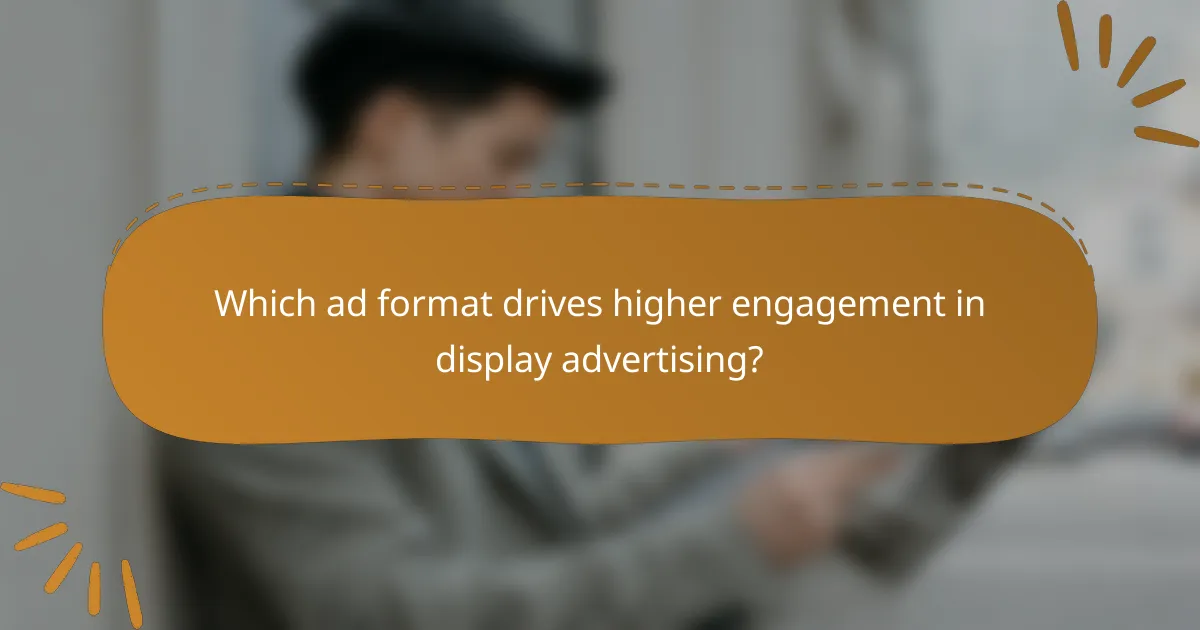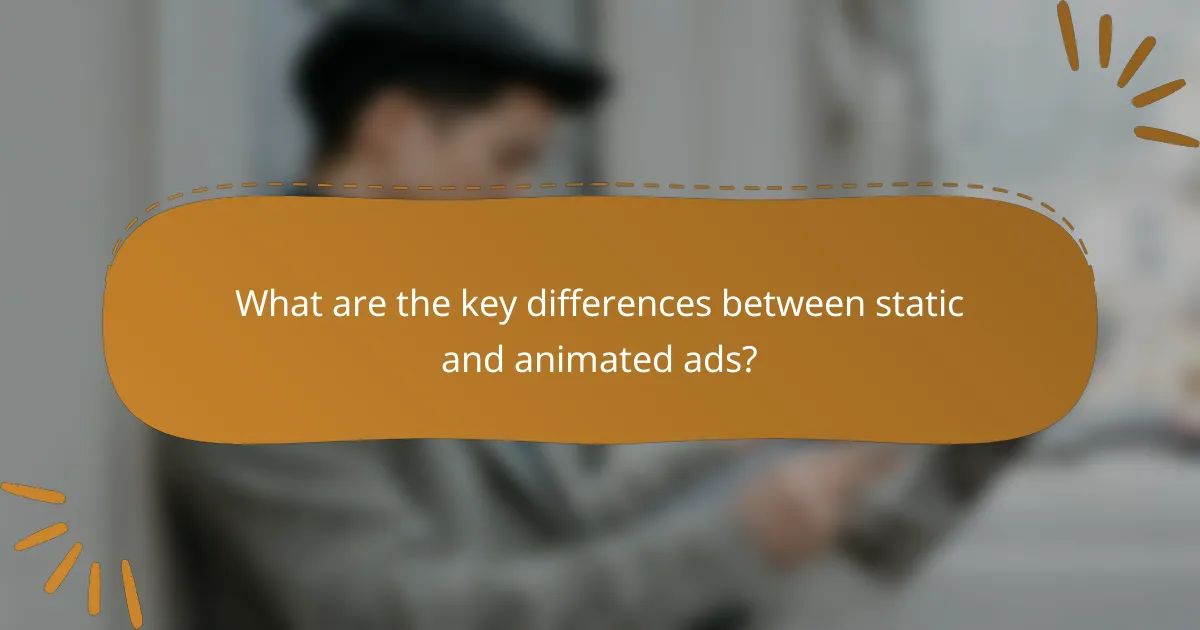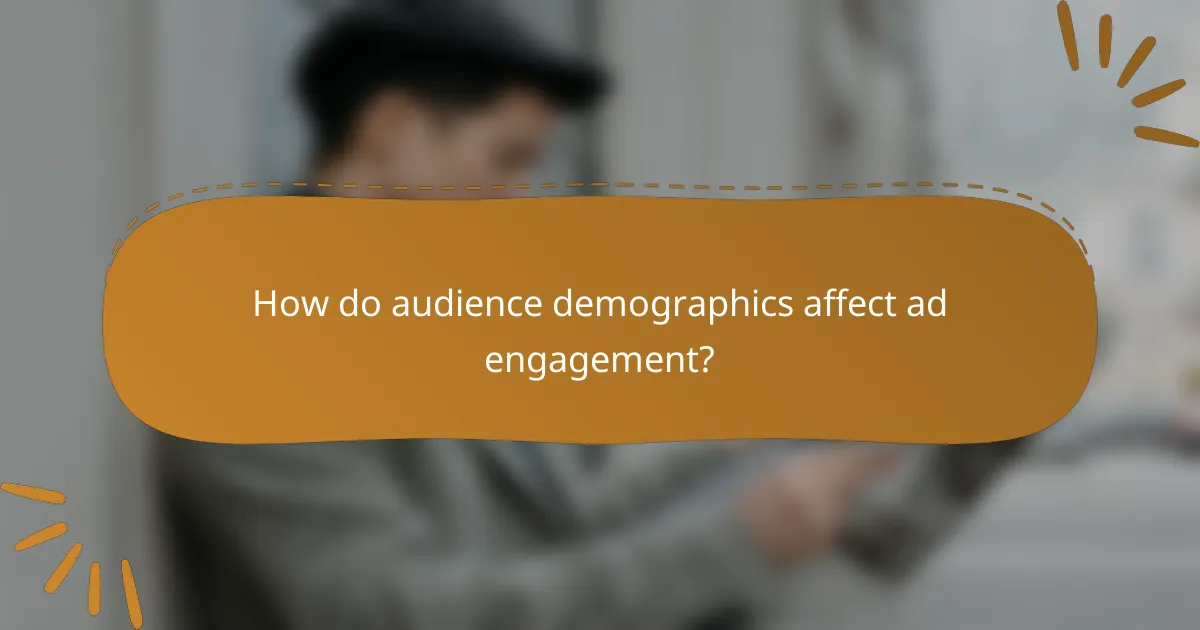In the realm of digital advertising, the debate between static and animated ads centers on engagement levels. Animated ads typically outperform their static counterparts by leveraging motion to capture attention and encourage interaction. However, the effectiveness of each format can vary based on campaign goals, target demographics, and budget constraints.

Which ad format drives higher engagement in display advertising?
Animated ads generally drive higher engagement in display advertising compared to static ads. This is due to their dynamic nature, which captures attention more effectively and encourages user interaction.
Animated ads outperform static ads
Animated ads tend to attract more viewers because they incorporate movement and sound, making them more visually stimulating. Research indicates that these ads can increase click-through rates significantly, often by double digits compared to their static counterparts.
For instance, a well-crafted animated ad can convey a story or highlight product features in a way that resonates with viewers, leading to better brand recall. Brands that utilize animations often see improved performance in terms of user engagement and conversion rates.
Static ads have lower engagement rates
Static ads typically experience lower engagement rates due to their lack of movement and interactivity. While they can effectively convey a message, they often fail to capture attention in a crowded digital space, leading to fewer clicks and interactions.
On average, static ads may yield click-through rates in the low single digits, which is considerably lower than animated ads. Advertisers should consider this when deciding on their ad strategy, as relying solely on static formats may limit their reach and effectiveness.

What are the key differences between static and animated ads?
Static ads are single images or graphics that convey a message quickly, while animated ads use motion to engage viewers over a longer duration. The choice between the two often depends on the campaign goals, target audience, and budget considerations.
Static ads are simpler and quicker to create
Static ads typically require less time and resources to produce, making them ideal for campaigns with tight deadlines. A single image can effectively communicate a brand message or promotion, often using minimal design elements.
For example, a well-designed banner ad can be created in a matter of hours, whereas animated ads may take days or weeks to finalize. This simplicity allows marketers to quickly test different visuals and messages to see what resonates best with their audience.
Animated ads offer dynamic storytelling opportunities
Animated ads can capture attention through movement and sound, making them suitable for storytelling and complex messages. They allow brands to convey emotions and narratives that static ads may struggle to express.
For instance, a short animated video can illustrate a product’s features in action, potentially increasing viewer engagement. However, creating these ads often requires more advanced skills and tools, which can increase production costs.

How do audience demographics affect ad engagement?
Audience demographics significantly influence ad engagement, with different age groups showing varying preferences for ad formats. Understanding these preferences can help marketers tailor their strategies to maximize engagement and effectiveness.
Young audiences prefer animated ads
Young audiences, particularly those in their teens to early thirties, tend to respond more positively to animated ads. These ads often capture attention quickly and convey messages in a dynamic and entertaining way, aligning with the fast-paced consumption habits of younger viewers.
For instance, platforms like TikTok and Instagram are popular among younger demographics, where animated content thrives. Marketers should consider using bright colors, quick transitions, and engaging storylines to appeal to this group.
Older audiences respond better to static ads
Older audiences, typically those over forty, often show a preference for static ads. This demographic may appreciate clear, straightforward messaging that static ads provide, as they tend to focus more on information rather than entertainment.
Static ads can be effective in traditional media, such as newspapers or magazines, where older individuals are more likely to engage. Marketers should prioritize clarity and simplicity in their designs, using larger text and familiar imagery to resonate with this audience.

What metrics should be used to measure engagement?
To effectively measure engagement, focus on metrics that reflect user interaction and conversion. Key metrics include click-through rates (CTR) and conversion rates, which provide insights into how well ads capture attention and drive desired actions.
Click-through rates (CTR)
Click-through rate (CTR) measures the percentage of users who click on an ad after seeing it. A higher CTR indicates that the ad resonates with the audience, prompting them to engage further. Typically, a good CTR for display ads ranges from 0.5% to 2%, but this can vary by industry and ad format.
When analyzing CTR, consider factors such as ad placement, targeting, and creative quality. For instance, animated ads may attract more clicks due to their dynamic nature, while static ads might perform better in specific contexts. Regularly testing different ad variations can help identify what works best for your audience.
Conversion rates
Conversion rate measures the percentage of users who take a desired action after clicking on an ad, such as making a purchase or signing up for a newsletter. A higher conversion rate indicates that the ad not only attracted clicks but also successfully encouraged users to complete the intended action. Conversion rates can vary widely, often ranging from 1% to 5% depending on the industry.
To improve conversion rates, ensure that the landing page aligns with the ad’s message and offers a seamless user experience. Consider using clear calls to action and optimizing for mobile devices. Additionally, analyze user behavior to identify potential barriers that may prevent conversions, such as lengthy forms or unclear navigation.

What are the best practices for creating effective animated ads?
Effective animated ads capture attention and drive engagement by following specific best practices. These practices ensure that the animation enhances the message rather than distracts from it.
Keep animations short and focused
Short animations, typically lasting between 5 to 15 seconds, are more effective at retaining viewer attention. Focus on a single message or theme to avoid overwhelming the audience with information.
Consider using quick transitions and limited scenes to maintain clarity. A clear narrative arc, even in a brief format, can help convey your message succinctly.
Use clear calls-to-action
A strong call-to-action (CTA) is essential in animated ads to guide viewers on what to do next. Ensure that the CTA is prominently displayed and easy to understand, using action-oriented language.
For example, phrases like “Shop Now” or “Learn More” can effectively prompt immediate responses. Position the CTA at the end of the animation for maximum impact, ensuring it aligns with the ad’s overall message.

What are the cost implications of static vs. animated ads?
The cost implications of static and animated ads vary significantly, influencing marketing budgets and strategies. Generally, animated ads tend to incur higher production costs due to the complexity of design and animation, while static ads are more economical and easier to produce.
Animated ads generally have higher production costs
Animated ads often require specialized skills, software, and more time to create, leading to increased production expenses. Costs can range from hundreds to thousands of dollars, depending on the length and complexity of the animation. For instance, a simple animated banner may cost around $500, while a full video ad could exceed $5,000.
Additionally, ongoing costs may arise from updates or changes, as animators may need to be hired again for revisions. Brands should weigh these costs against the potential for higher engagement and conversion rates that animated ads can offer.
Static ads are more budget-friendly
Static ads are typically less expensive to produce, making them an attractive option for businesses with limited budgets. The costs for static ads can start as low as $100 for basic designs and can go up to a few thousand dollars for more intricate graphics. This affordability allows brands to allocate funds to other marketing areas.
Moreover, static ads can be quickly created and modified, which is beneficial for time-sensitive campaigns. However, while they are budget-friendly, brands should consider the potential trade-off in engagement levels compared to animated ads.

How can A/B testing improve ad performance?
A/B testing can significantly enhance ad performance by allowing marketers to compare different ad formats and determine which one resonates more with their audience. By systematically testing variations, businesses can identify the most effective elements that drive engagement and conversions.
Test different formats to find optimal engagement
Testing various ad formats, such as static versus animated ads, helps in pinpointing which type captures the audience’s attention more effectively. For instance, a business might find that animated ads yield higher click-through rates compared to static ones, or vice versa, depending on the target demographic.
Consider running tests with a sample size that reflects your audience, ideally in the low hundreds to low thousands, to gather meaningful data. Monitor key performance indicators (KPIs) like engagement rates, conversion rates, and average time spent on the ad to evaluate performance accurately.
Analyze audience responses to refine strategies
Understanding audience responses is crucial for refining advertising strategies. After conducting A/B tests, analyze the data to see which ad format performed better and why. Look for patterns in demographics, preferences, and behaviors that can inform future campaigns.
Utilize tools that provide insights into user interactions, such as heat maps or click tracking, to gain a deeper understanding of how viewers engage with different ad types. This analysis will help in making data-driven decisions that align with audience expectations, ultimately improving ad effectiveness.
